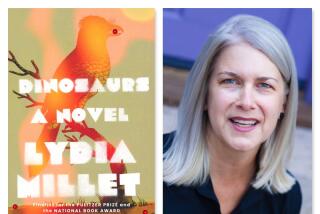Deep Into Dinosaurs : PBS Documentary Separate Myth from Warmblooded Facts
- Share via
Noted paleontologist Robert Bakker knows why people’s love affairs with dinosaurs begin when they are children.
“There are two theories,” said Bakker, 48, adjunct curator of paleontology at the University of Colorado museum. “One theory is that it is a childhood disease related to mumps and just goes right through the second grade and everybody gets it.
The other theory, and “the correct one, is that dinosaurs are nature’s special effects,” said Bakker, who fell in love with dinos when he was 9 after reading about them in Life magazine.
“If you like the fantastic, if Steven Spielberg is your favorite movie producer, then you’ve got to love dinosaurs,” Bakker said. “Even kindergarten kids know the difference between dinosaurs and dragons. Dragons are made up and dinosaurs are not. That is a tremendous hook. I find a lot of first- and second-graders are really into (dinosaurs).”
Bakker is one of the many scientists featured throughout the PBS four-part documentary series “The Dinosaurs!” premiering Sunday. Filmed in more than 50 locations in North America, Europe and South America, the series focuses on the research of the new breed of paleontologist who travel the globe looking for clues that will help them unlock the secrets of life on Earth more than 100 million years ago. The series features animation, graphics and sound effects to illustrate the prehistoric world.
Paleontologists, who first began studying dinosaurs about 200 years ago, have made startling discoveries of what the world was like in the Mesozoic Era. For example: Dinosaurs were not slow, sluggish coldblooded creatures but were actually warmblooded animals related to today’s chickens, turkeys and ostriches.
Bakker said schoolchildren often ask him if there will still be dinosaurs to be found by the time they grow up. He always tells them only a couple of hundred of dinosaurs have been discovered and there are tens of thousands still waiting to be dug up. “Dinosaurs evolved real fast,” he said. “That is one mark of their hotbloodedness.”
In fact, Bakker recently found a new species of dinosaur at Como Bluff, Wyo. The dinosaur, from the end of the Jurassic Age, is a tiny plant-eater about the size of a small turkey. Bakker was especially thrilled because it was a complete skelton.
In fact, he said, a whole family of these tiny dinos, including babies, have been found. “We found the first one four years ago, and it turns out in this particular time in this particular habitat to be the most common dinosaur,” Bakker said. “Your average intelligent viewer of PBS wouldn’t think that some dinosaurs were tiny, some dinosaurs would migrate across the snow. That is the beauty of the age we live in. We are finding out more and more and unlearning more and more about dinosaurs than any other time.”
One oldwives tale about dinosaurs that has been put to rest was that dinosaurs were stupid. “A lot of the little ones were the brightest animals around back then,” Bakker said. “A lot smarter than our own ancestors. The tiny plant-eaters and meat-eating dinosaurs had brains four or five times bigger than ours for their body size.”
The idea that dinosaurs were warmblooded creatures related to the bird, Bakker said, is a theory actually from the 19th Century that was widely taught until the 1920s. For the next 40 years the coldblooded theory was expounded by scientists “because rather dull people were doing dinosaurology,” Bakker said. “It wasn’t cool to study dinosaurs. Hardly anyone studied dinosaurs and the science just literally drifted. In the ‘70s, there was what we call the dinosaur renaissance.”
Another misconception about dinosaurs is their color. It is believed they were gray like elephants, rhinos and hippos. Not true, according to Bakker.
“The reason those animals are gray is because they are color blind,” Bakker said. “Animals who have bright colors see color and use color to advertise themselves doing courtships. Dinosaur eyeballs were constructed like birds and so were their brains.
“They were color-coated critters. A bull brontosaurus, we can absolutely be sure, was not gray. There were bright colors on his throat and neck and the same was true for all dinosaurs.”
“The Dinosaurs!” airs Sunday-Wednesday at 7 p.m. on KVCR, 8 p.m. on KCET and KPBS, and 10 p.m. on KOCE.
More to Read
The complete guide to home viewing
Get Screen Gab for everything about the TV shows and streaming movies everyone’s talking about.
You may occasionally receive promotional content from the Los Angeles Times.







